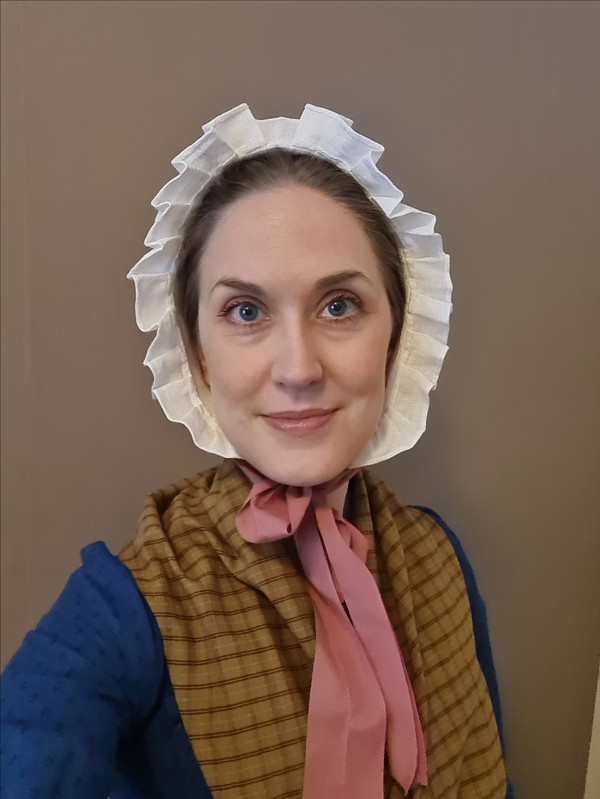The next step in the house-maid outfit was a cap. It looks easy enough: a white cap with frills, tied under the chin with a pink ribbon.
White cap (caul, headband, frills) with a pink ribbon.
Tjenestepige (maidservant) by Johannes Senn and G.L. Lahde. Danish, Ca. 1810. From “Klædedragter i København” (Clothing of Copenhagen)
I googled and googled and googled. There are a lot of frilly caps about on Pinterest (a wonderful tool, but it tends to clog up your googling something fierce), but noone that looked quite like the one above. At this point the larp was looming in the very near future, so I decided for the next best thing and a very larpy one at that: find an "authentic" pattern and then add a pink ribbon (none of the extant ones I found, even if I was generous with the datings of said caps, had a pink ribbon). I was fairly certain that while colouring might alter what I saw colour-wise, it was definately a ribbon of some sort in involved.
E-patters are great when you are short of time, and I found that
Burnley and Trowbridge's was even more helpful: with the help of their printed scale I could actually measure on of the two caps and draft a pattern without having to make a detour to find a printer first.
After that, I simply followed their
sew-along. Again, I went for stash busting which meant that while the sew-along use a thin cotton muslin, I used a semi-thin linen. That made the pleating and gathering something of a challenge (I gathered the caul and realised that I would never make that work with the frills, so pleated them instead). Other than that, I found the sew-along very nice and easy to follow, apart from that they tell you everything in detail except how to pleat around a corner. Which is like the trickiest part? Anyway, I can highly recommend it!
The finished cap looked nice enough (though I am still not entirely sure how it's supposed to stay on your head the minute "wind" enters the equation), and I even hesitated if I should add a ribbon at all. In the end I did, since I wanted to try to mimic the inspiration picture as far as possible. I think the original is likely to be a silk ribbon (because of the painted lustre, and because a silk ribbon is a reasonably indulgence also for a house-maid), but I had either super shiny icky polyester satin ribbons in the wrong colour (that I would have to buy especially) or a bit too thin cotton ribbon that I picked up at a boot sale this summer. Crazy person that I am, I set out to baste two lengths of ribbon together for a bitter width. Because that is totally a reasonable thing to do with about two days to go before a laro, especially for a "I just want to try how it looks".
To my surprise, I didn't hate the result (??) so I kept it.
The result:
The finished cap, and also a costume test of the outfit that far. The fichu was a bit too short to sit nicely when crossed across the chest, so I simply hid the ends under the apron for a "roughly the right look". I am reasonably pleased.
A front view (my Henry VII cast eye is always more visible when I wear lenses and am a bit tired...). The slightly too think pleats made the frills stand out a bit, which I don't dislike.
Side view since the ribbon doesn't quite show in three quarter profile.
The facts:
What the item is: An 18th century cap with a 19th century twist.
How it fits the challenge: It's on my head :D
Material: Linen
Pattern: Burnley and Trowbridge
Year: 18th-early 19th century
Notions: Linen and silk thread, cotton ribbon
How historically accurate is it? The cap itself is, I think, close to 100%. The addition of the ribbon mixes it up a bit, but I would still say about 90%. Yay!
Hours to complete: About 10 including cutting etc. All hand sewn.
First worn: At
The Austen Experience, mid December 2021.
Total cost: The cap is made entirely from small scraps from other projects, so a token 1 euro or something. The entire roll of ribbon (much is left) was 1 euro as well, so with thread and all about 2 euros.





